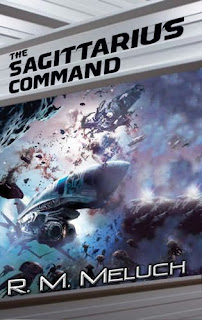 A little departure for us today, an old-fashioned space opera (known these days as "military sf") with a couple of interesting twists.
A little departure for us today, an old-fashioned space opera (known these days as "military sf") with a couple of interesting twists.The Sagittarius Command is the third volume in R. M. Meluch's series, The Tour of the Merrimack. The known galaxy is dominated by two interstellar empires, the United States of America and the Palatine Empire, a resurrected Rome. In previous volumes, we've seen the reaction of both to the advent of the Hive, an alien species that travels in groups, seems to have no particular intelligence other than a hive-mind, and eats anything organic in its path. In previous volumes we've seen the discovery of the Hive, the victory of the Merrimack over Roman forces that enabled its captain, John Farragut, to enforce an alliance (called by the Romans "The Subjugation," and bitterly resented), and gotten a good idea of the political context, both interstellar and earthbound.
This installment begins with a surprise encroachment by the Hive on a Roman colony in Near Space, close to both Palatine and Earth. Farragut and the Merrimack are able to save most of the inhabitants and destroy the Hive (individually known as "gorgons," "soldiers," and "gluies," depending on the type), much to the disgust and resentment of its Roman garrison, Legion LXXI Draconis, and its commander, Herius Asinius. The Dracs wind up as part of Attack Group I when the allied strategy changes and it looks as though the point of origin of the Hive has been located.
Meluch's earlier works were relatively straightforward, hard-edged, poetic stories. The edge is here, as well, but this series is a space opera with a lot of intrigue and political maneuvering -- try to think of a cross between E. E. "Doc" Smith and C. J. Cherryh. She also set up an anomaly in the first volume that continues to play itself out, although at this stage I'm beginning to wonder whether it's a device she's actually going to use, or she's just playing with our heads: at the end of The Myriad, she shifted everything into an alternate universe. We're still in that universe, but the previous one does crop up in something that Farragut remembers that he shouldn't.
Characters, by the way, are a treat: larger than life, and basically stereotypical, but strongly drawn, and they do manage to surmount their origins to become real people. And the relationship between Farragut and Augustus, a Roman patterner, is a nice, edgy, not-quite-homoerotic kind of thing (although Augustus' interest is not entirely platonic). (Augustus' brain and body have been altered to enable him to process vast amounts of data and draw connections; he has no memory of anything before that process began.)
I've reviewed previous volumes in other places. The Myriad is at Rambles, and Wolf Star at Epinions. This one's published by DAW.
No comments:
Post a Comment